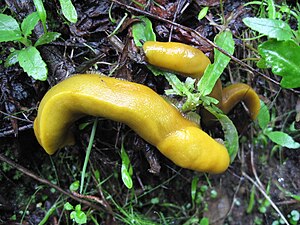Ariolimax stramineus
| Ariolimax stramineus | ||||||||||||
|---|---|---|---|---|---|---|---|---|---|---|---|---|

Ariolimax stramineus , Big Sur |
||||||||||||
| Systematics | ||||||||||||
|
||||||||||||
| Scientific name | ||||||||||||
| Ariolimax stramineus | ||||||||||||
| Hemphill , 1891 |
Ariolimax stramineus , which is also known as the banana snail because of its mostly yellow color, is a land-dwelling slug from the family of the Ariolimacidae in the suborder of the land snails (Stylommatophora).
features
The animals are medium-sized, comparatively slender, and stretched out 13 to 16 cm long. Adult animals weigh 20 to 25 g, in exceptional cases up to 27 g. The basic color varies from glassy lemon yellow to light straw yellow; the coat is the same color. They are indistinctly elongated. They intersect with transverse or oblique stripes that are equally indistinct or even missing. The sole of the foot is wider than the back and gray. The side parts of the sole are more or less noticeably darker than the middle part, or even the same color. The lateral parts of the foot are gray. The keel extends from the coat shield to the tip of the tail.
In the genital apparatus, the penis is moderately long, club-shaped and slender, narrowing towards the mouth in the atrium. The apex is broadly rounded. The spermatic duct is comparatively short, not looped and thin. The lower half up to the mouth in the penis is a little thicker. The spermatic duct ends almost at the top of the penis, right next to the ribbon-shaped penile retractor muscle, which attaches fairly precisely to the top of the apex. The vagina is tubular, relatively long, moderately wide, and straight. The stem of the seminal vesicle (spermathek), the seminal vesicle conductor, is moderately long and very wide, which makes it appear that the vagina is divided into two. A retractor muscle attaches in the upper part of the vagina to about the mouth of the seminal vesicle duct. The free fallopian tube is very short, straight and thick-cylindrical. The atrium is very flat.
Similar species
The sexual apparatus of Ariolimax stramineus and Ariolimax columbianus show some similarities, but also some differences. The other species of the genus Ariolimax , however, show very clear differences in the sexual apparatus. According to external characteristics, the types of banana snails are difficult to distinguish. With Ariolimax columbianus the penis is somewhat thicker, the penile retractor muscle is broadly attached to the top of the apex and encloses the entrance of the seminal duct into the penis. In Ariolimax stramineus , the spermatic duct enters the penis next to the retractor muscle. The vagina is a little wider in Ariolimax columbianus , especially the upper and lower parts are separated by a small, powerful sphincter muscle, which is missing in Ariolimax stramineus . The stem of the seminal vesicle is shorter in Ariolimax columbianus . With Ariolimax stramineus , the free fallopian tube is much shorter and because of this shortness it cannot be put in loops, as is the case with Ariolimax columbianus .
Geographical distribution and habitat
Ariolimax stramineus occurs on the coast of California south and a little west of the Salinas Valley from the Monterey Peninsula to Ventura County , Santa Cruz - and Santa Rosa Island .
In contrast to the other Ariolimax species, this species lives in fairly dry areas. The range extends farthest south, apart from a species not yet described in San Diego County .
Way of life
Little is known about the way of life of this species, as it was previously considered a subspecies of Ariolimax columbianus . Leonard & Pearse reported in a guest lecture at the University of California at Santa Cruz that there is no apophallation in this species as in Ariolimax columbianus ; This means that one of the two sexual partners "bites off" the penis that is in the vagina of the other during mating.
Taxonomy
The taxon was first described by Henry Hemphill in 1891 as Ariolimary columbianus var. Straminea . Ariolimary is a typo for Ariolimax . Mead (1943) interpreted the taxon as a subspecies of Ariolimax columbianus . Recent molecular genetic studies suggest that the taxon is a separate species. Accordingly, Ariolimax stramineus is rated as an independent species in the latest studies.
The genus Ariolimax is divided by some authors into two sub-genera Ariolimax (Ariolimax) Mörch, 1860 and Ariolimax (Meadarion) Pilsbry, 1948. In this structure Ariolimax stramineus is placed in the subgenus Ariolimax .
supporting documents
literature
- Mead, Albert R. 1943: Revision of the Giant West Coast Land Slugs of the Genus Ariolimax Moerch (Pulmonata: Arionidae). American Midland Naturalist, 30 (3): 675-717, Notre Dame, Indiana, JSTOR 2421208 .
- Pilsbry, Henry Augustus 1948: Land Mollusca of North America: (north of Mexico). Vol. 2 Part II. The Academie of Natural Sciences of Philadelphia, Monographs, 3: XLVII S., pp. 521–1113, online at Google Books (p. 710)
Individual evidence
- ^ A b John Pearse and Jane Leonard: All About Banana Slugs. University of California, Santa Cruz Banana Slug Genomics class, April 23, 2010 PDF (175 MB!)
- ^ Henry Hemphill: Ariolimary [sic] Columbianus var. Straminea. Nautilus, 4: 120, 1891 Online at www.biodiversitylibrary.org .
- ↑ Pearse, JS, Leonard, JL; Breugelmans, K .; Backeljau, T. 2007: Banana slug clades and proposed taxonomy. Society of Integrative and Comparative Biology, Annual Meeting 2007 Abstract
- ↑ McDonnell, Rory, Timothy D. Paine, Michael J. Garmally 2009: Slugs A Guide to the Invasive and Native Fauna of California. University of California Division of Agriculture and Natural Resources, Publication 8336: 21 S., Oakland, Calif. Google Books (p. 9)
annotation
- ↑ The common name banana snail is also used for other closely related species of the genus Ariolimax .